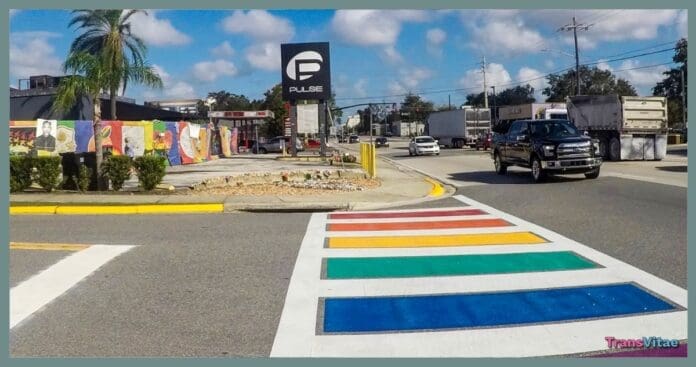In Orlando, what began as a simple, powerful memorial, 59 feet of rainbow-colored crosswalk honoring the 49 lives lost in the Pulse nightclub massacre, has turned into a grim theater of state overreach and symbolic aggression.
Originally installed in 2017 with the Florida Department of Transportation’s (FDOT) approval, the rainbow crosswalk was not just road paint. It was a site of healing, a public testament to grief, resilience, and LGBTQ+ pride.
Fast-forward to August 2025: crews removed the crosswalk overnight without warning. FDOT justified the move by citing an updated manual forbidding “non-uniform traffic control devices,” especially those deemed “social, political, or ideological.” This was despite the crosswalk having undergone a formal compliance process and not being on the list of noncompliant sites.
The result is a state-sanctioned historical erasure. The petty part is that this tribute was never flagged as problematic until pressure from above made it one.
The public reaction has been electric. Community members flocked back to the site, armed with chalk, to reclaim the memorial through art. Florida Highway Patrol and Orlando Police officers quietly supervised, their presence lingering like a thinly veiled threat. The unspoken message was clear: keep your grief clean, sanitized, and out of sight.
Rep. Anna Eskamani, visibly frustrated, called it out: “You would think our state has bigger problems to solve, but NOPE, this is what they’ve committed public dollars and time towards.”
Local leaders condemned the move as well. Commissioner Patty Sheehan called the midnight erasure a “slap in the face,” asking a question that cuts to the marrow: “If they are so proud of it, why did they do it in the middle of the night?”
Meanwhile, FDOT insists its goal is roadway safety and uniformity, not erasure. They claim that efforts are underway, funded by the City of Orlando and Orange County, to construct a permanent memorial on adjacent property.
Here is the thing: a permanent memorial should build on history. Erasing a living tribute in the name of neutrality turns neutrality into a weapon when it hurts marginalized communities most.
For survivors, families, and LGBTQ+ folks everywhere, the crosswalk is more than aesthetic. It is a heartbeat rendered in color. And when the state buffed it away, that heartbeat was criminalized.
Yet chalk and rainbow flags remain defiant. The message is clear: we will not be erased, and our mourning will not be sanitized by political agendas.
The Bottom Line
Memorials are meant to hold our grief and our hope in equal measure. To obliterate them under the guise of “safety” is not safety; it is erasure dressed up in bureaucratic rhetoric. And when that erasure targets LGBTQ+ remembrance, it becomes more than tone-deaf: it becomes cruel.
Let us keep drawing, coloring, remembering, and demanding that our grief, joy, and identity hold space in the public realm.


